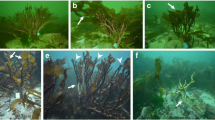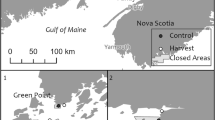Abstract
Several aspects of the growth of the agarophyte Gelidium sesquipedale Clemente (Thuret) were studied in sublittoral populations of the Basque coast (northern Spain) from 1981 to 1986. The standing stock of the populations varied greatly with season. During two consecutive years, 60 to 70% of summer biomass had been lost by the end of the unfavourable period of year to growth (autumn and winter). The decline in biomass was mainly due to partial losses of branches, with more branches being lost from larger fronds. Yearly variations in the standing stock were also recorded. Production estimates obtained by a destructive sampling method were not satisfactory because of the spatial heterogeneity of the populations at the three locations studied. Indirect estimation of production by measuring the growth of marked fronds in a control quadrat gave more reliable estimates. Production values of ∼622±124, 735±147 and 615±123 g dry wt m-2 yr-1 were obtained at the three locations, respectively. Frond elongation rates of 7.5, 6.1, 7.5 and 7.9 cm yr-1, respectively, were recorded during four consecutive years. In winter elongation rates of fronds were rather low. Elongation did not seem to be affected by frond length, the self-shading effect of the canopy, or changes in depth. Cuts resulting from grazing were frequent on fronds through the year, decreasing significantly with increasing depth. Sheared fronds regenerated promptly, independent of season or height at which the cut was made. For commercial purposes the best season for harvesting is summer, which is the period of maximum standing stock, infertility, and calm warm waters that provide easier working conditions for divers.
Similar content being viewed by others
References
Abbott IA (1980) Seasonal population biology of some carrageenophytes and agarophytes. In: Abbott IA, Foster MS, Eklund LF (eds) Pacific seaweed aquaculture. California Sea Grant College Program, University of California, La Jolla, pp 45–53
Akatsuka I (1986) Japanese Gelidiales (Rhodophyta), especially Gelidium. Oceanogr mar Biol A Rev 24:171–263
Anadón R, Fernández C (1986) Comparación de tres comunidades de horizontes intermareales con abundancia de Gelidium latifolium (Grev.) Born et Thur en la costa de Asturias (N de España). Investigación pesq 50:353–366
Barilotti DC, Silverthorne W (1972) A resource management study of Gelidium robustum. Proc int Seaweed Symp 7:255–261 [Nisizawa K (ed) University of Tokyo Press, Tokyo]
Borja A (1987) Cartografía, evaluación de la biomasa y arribazones del alga Gelidium sesquipedale (Clem.) Born et Thur en la costa guipuzcoana (N España). Investigación pesq 51:199–224
Bulthuis DA, Woelkerling WJ (1983) Seasonal variation in standing crop, density and leaf growth rate of the seagrass, Heterozostera tasmanica, in Western Port and Phillip Bay, Victoria, Australia. Aquat Bot 16:111–136
Burns RL, Mathieson AC (1972) Ecological studies of economic red algae. III. Growth and reproduction of natural and harvested populations of Gigartina stellata (Stackhouse) Batters in New Hampshire. J exp mar Biol Ecol 9: 77–95
Carter AR, Anderson RJ (1986) Seasonal growth and agar contents in Gelidium pristoides (Gelidiales, Rhodophyta) from Port Alfred, South Africa. Botanica mar 29:117–123
Cendrero O, Ramos F (1967) Trabajos sobre las algas del género Gelidium en la provincia de Santander. Publnes téc Junta Estud Pesca, Madrid 6: 283–290
Chapman ARO (1974) The ecology of macroscopic marine algae. A Rev Ecol Syst 5:65–80
Cheong YK, Cheong DY (1970) Fundamental studies on the propagation of Gelidium amansii Lmx. Bull Fish Res Dep Ag Pusan 5:85–93 [In Jap.]
Conover JT (1964) The ecology, seasonal periodicity and distribution of benthic plants in some Texas lagoons. Botanica mar 7:4–41
Coon LM (1980) Macrocystis harvest strategy in British Columbia. In: Srivastava LM (ed) Synthetic and degradative processes in marine macrophytes. Walter de Gruyter, Berlin, pp 339–346
De Wreede RE (1985) Destructive (harvest) sampling. In: Littler MM, Littler DS (eds) Handbook of phycological methods. Ecological field methods: macroalgae. Cambridge University Press, Cambridge, pp 147–160
Dixon PS (1958) The structure and development of the thallus in the British species of Gelidium and Pterocladia. Ann Bot (NS) 22: 353–368
Echegaray J, Seoane-Camba JA (1982) Estudio comparativo sobre la variación morfológica y fisiológica de Gelidium crinale y Gelidium spathulatum colectados en el Mediterráneo catalán. Collnea bot, Barcelona 13:803–816
Elliot JM (1977) Some methods for the statistical analysis of samples of benthic invertebrates. 2nd edn Freshwater Biological Association, Ambleside, England (Freshwat biol Publ No 25)
Felicini GP (1970) Ricerche sulla rigenerazione in coltura di Pterocladia capillacea. 2. Influenza dell'intensitá luminosa sulla morfologia del tallo. G bot ital 104:35–47
Felicini GP, Arrigoni O (1967) Ricerche sulla rigeneratione in coltura di Pterocladia capillacea. G bot ital 101:123–129
Felicini GP, Perrone C (1986) Une étude en lumière polarisée sur le parcours des hyphes dans le thalle de Pterocladia capillacea (Gelidiaceae, Rhodophyta). Phycologia 25:37–46
Fernández C (1980) Estudios estructurales y dinámica del fitobentos intermareal (facies rocosa) de la región de cabo Peñas, con especial atención a la biología de Saccorhiza polyschides (Le Jol.) Batt. Doctoral thesis. University of Oviedo, Oviedo
Foster MS, Schiel DR (1985) The ecology of giant kelp forests in California: a community profile. US Fish Wildl Serv biol Rep 85 (7.2):1–152
Fralick RA, Andrade F (1981) The growth, reproduction, harvesting and management of Pterocladia pinnata (Rhodophyceae) in the Azores. Portugal. Proc int Seaweed Symp 10:289–295 [Levring T (ed) Walter de Gruyter, Berlin]
Gerard VA (1976) Some aspects of material dynamics and energy flow in a kelp forest in Monterey Bay, California. Doctoral thesis. University of California Santa Cruz
Gerard VA, North WJ (1984) Measuring growth, production, and yield of the giant kelp, Macrocystis pyrifera. Hydrobiologia 116/117:321–324
Guzmán del Próo SA, de la Campa de Guzmán S (1979) Gelidium robustum (Florideophyceae), an agarophyte of Baja California, México. Proc int Seaweed Symp 9:303–308 [Jensen A, Stein JR (eds) Science Press, Princeton]
Hansen JE (1977) Ecology and natural history of Iridaea cordata (Gigartinales, Rhodophyta) growth. J Phycol 13:395–402
Hansen JE (1980) Physiological considerations in the mariculture of red algae. In: Abbott IA, Foster MS, Eklund LF (eds) Pacific seaweed aquaculture. California Sea Grant College Program, University of California, La Jolla, pp 80–91
Hansen JE (1983) A physiological approach to mariculture of red algae. J Wld Maricult Soc 14:380–391
Johnstone GR, Feeney FL (1944) Periodicity of Gelidium cartilagineum, a perennial red alga. Am J Bot 31:25–29
Juanes JA, Fernández C (1988) Ciclo anual y producción de Gelidium latifolium (Grev.) Thur et Born (1876), en la región de cabo Peñas (Asturias, N de España). Investigación pesq 52:109–122
Kain JM (1963) Aspects of the biology of Laminaria hyperborea. II. Age, weight and length. J mar biol Ass UK 43:129–151
Kaliaperumal N, Umamaheswara Rao M (1981) Studies on the standing crop and phycocolloid of Gelidium pusillum and Pterocladia heteroplatos. Indian J Bot 4:91–95
Kaliaperumal N, Umamaheswara Rao M (1986) Growth, reproduction and sporulation of marine alga Gelidium pusillum (Stackhouse) Le Jolis. Indian J mar Sci 15:29–32
Katada M, Satomi M (1975) Ecology of algae. In: Tokida J, Hirose H (eds) Advance of phycology in Japan. Gustav Fischer Verlag, Jena, pp 211–239
Lancelot A (1953) Sur les Gélidiales de la côte Basque. C r Ass fr Avanc Sci (Extrait Act Congr Luxemb) 72:511–514
Lee IK, Kim YH, Lee JH, Hong SW (1975) A study on the marine algae in the Kwang Yang Bay. I. The seasonal variation of algal community. Korean J Bot 18:109–121
Macler BA, West JA (1987) Life history and physiology of the red alga, Gelidium coulteri, in unialgal culture. Aquaculture, Amsterdam 61:281–293
Mairh OP, Sreenivasa Rao P (1978) Culture studies on Gelidium pusillum (Stackh.) Le Jolis. Botanica mar 21:169–174
Mann KH (1969) The dynamics of aquatic ecosystems. Adv ecol Res 6:1–81
Matsuura S (1958) Observations on the annual growth cycle of marine algae on a reef at Manadzuru on the Pacific coast of Japan. Bot Mag, Tokyo 71:93–109
Montalva S, Santelices B (1981) Interspecific interference among species of Gelidium from central Chile. J exp mar Biol Ecol 53: 77–88
Murthy MS, Ramakrishna T, Sarat Babu GV, Rao YN (1986) Estimation of net primary productivity of intertidal seaweeds-limitations and latent problems. Aquat Bot 23:383–387
Nonaka T, Osuga H, Sasaki T (1962) Fundamental studies on Gelidium propagation (VII). Growth of Gelidium and recovery after harvest. Sizuoka-ken Suisan Sikenzyô Izu Bunzyô Kenkyû Hôkoku, No 18: 1–4 [In Jap.] (Cited after Katada and Satomi 1975)
North WJ (1971) Growth of individual fronds of the mature giant kelp Macrocystis. In: North WJ (ed) The biology of giant kelp beds (Macrocystis) in California. VJ Cramer, Lehre, Germany, pp 123–168
Norton TA, Mathieson AC, Neushul M (1981) Morphology and environment. In: Lobban CS, Wynne MJ (eds) The biology of seaweeds. Blackwell Scientific Publications, Oxford, pp 421–451
Oliger P, Santelices B (1981) Physiological ecology studies on Chilean Gelidiales. J exp mar Biol Ecol 53:65–75
Oliveira JC (1984) Notas sobre o crescimento de Gelidium sesquipedale (Clem.) Born et Thur, na costa ocidental portuguesa. Acta IV Simp ibér Estudios Bentos mar 3:51–62
Oliveira Filho EC de, Sazima IP (1973) Estudos sobre a biologia de algas agarófitas. I. Recolonizacão, brotamento e fenologia em populaçöes naturais de Pterocladia capillacea (Rhodophyta-Gelidiaceae). Bolm Zool Biol mar (NS), Univ S Paolo 30:677–690
Ono I (1932) Hokkaidô ni okeru Senkai Riyô: Suisan Zôsyoku Kôwa Hokkaidô Suisan Kai, Sapporo [In Jap.] (Cited after Akatsuka 1986)
Prince JS, Kingsbury JM (1973) The ecology of Chondrus crispus at Plymouth, Massachusetts. II. Field studies. Am J Bot 60: 964–975
Reguera B, Salinas JM, Gancedo R (1978) Biometria en Gelidium sesquipedale (Rhodophyta). 2a Parte. Boln Inst esp Oceanogr 4: 101–138
Robertson BL (1988) Management of Gelidtum pristoides resources. In: Branch GM, Shackleton LY (eds) Research needs in the Transkei and Ciskei coastal zone. Rep S Afr natn scient Progms 155: 16–18
Round FE, Hickman M (1984) Phytobenthos sampling and estimation of primary production. In: Holme NA, McIntyre AD (eds) Methods for the study of marine benthos. Blackwell Scientific Publications, Oxford, pp 245–283
Salinas JM (1987) Localización de los campos industriales de Gelidium sesquipedale. Perspectivas de cultivo. Primeras Jornadas de Acuicultura de la Comunidad Autónoma Cantabria. Gobierno de Cantabria, Santander, pp 127–166
Salinas JM, Reguera B, Gancedo R (1976) Biometria en Gelidium sesquipedale (Rhodophyta). Primera parte. Boln Inst esp Oceanogr 226:1–70
Santelices B (1977) Ecología de algas marinas bentónicas-efecto de factores ambientales. Pontificia Universidad Católica de Chile, Santiago
Seoane-Camba J (1966) Algunos datos de interés en la recolección de Gelidium sesquipedale. Publnes téc Junta Estud Pesca, Madrid 5:437–455
Seoane-Camba J (1969) Crecimiento, producción y desprendimiento de biomasa en Gelidium sesquipedale (Clem) Thuret Proc int Seaweed Symp 6:365–374 [Margalef R (ed) Imprenta Juvenil Barcelona, Santiago de Compostela]
Silverthorne W (1977) Optimal production from a seaweed resource. Botanica mar 20:75–98
Stewart JG (1984) Vegetative growth rates of Pterocladia capillacea (Gelideaceae, Rhodophyta). Botanica mar 27:85–94
Yamada N (1976) Current status and future prospects for harvesting and resource management of the agarophyte in Japan. J Fish Res Bd Can 33:1024–1030
Author information
Authors and Affiliations
Additional information
Communicated by J. M. Pérès, Marseille
Rights and permissions
About this article
Cite this article
Gorostiaga, J.M. Growth and production of the red alga Gelidium sesquipedale off the Basque coast (northern Spain). Marine Biology 120, 311–322 (1994). https://doi.org/10.1007/BF00349693
Received:
Accepted:
Issue Date:
DOI: https://doi.org/10.1007/BF00349693




